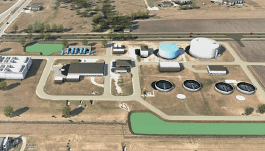Federal loan helps Texas utility expand treatment system and fight invasive mollusks
January 12, 2023

AWWA Articles
Federal loan helps Texas utility expand treatment system and fight invasive mollusks
A fast-growing suburb of Austin, Texas, was granted the state’s first Water Infrastructure Finance and Innovation Act (WIFIA) loan, allowing the city to expand its treatment plant and address zebra mussel damage.
“It’s going to save ratepayers a bunch of money,” said Brandon Pritchett, public utilities director for the city of Pflugerville. “And anytime you can do that for ratepayers, it’s worth it.”
 In early November, the U.S. Environmental Protection Agency (EPA) announced a $52 million WIFIA loan to support the city of Pflugerville’s water treatment plant expansion project. (At right, rendering of plant once expansion is completed.)
In early November, the U.S. Environmental Protection Agency (EPA) announced a $52 million WIFIA loan to support the city of Pflugerville’s water treatment plant expansion project. (At right, rendering of plant once expansion is completed.)
Construction on the three-year effort will begin in January and increase the plant’s capacity from 17.7 million gallons per day to 30 million, meeting the area’s projected demand through 2050. The project includes a new copper ion generation system to eliminate infrastructure-damaging zebra mussels, as well as new pumps, motors, multiple pump stations and backwash clarifier, among other improvements.
“I’m really excited about the project,” Pritchett said. “It’s what residents deserve as far as a quality product that will withstand the test of time.”
Pflugerville is a 30-minute drive from the state capital. Founded in 1860, the city was named in honor of local farmer Henry Pfluger, a German surname that means “plowman.” The city embraces the silent P in its name, hosting a Pfarmers Market, Phine Art Pfest and Pfestival of Lights.
What started as a ranching and farming community of a couple hundred is now one of the fastest growing cities in central Texas and now serves water to 76,000 people. Samsung and Tesla are building factories on either side of Pflugerville, “and we’ll have to serve water to all those residents as they move in,” Pritchett said.
The city is funding the $144 million water treatment plant expansion project via three sources: $52 million from WIFIA, $24 million from the Texas Water Development Board, and the remaining from cash, impact fees and other debt issuance.
The WIFIA loan is expected to save the city $13.2 million over the lifetime of the loan, which made for an easy decision to serve as the state’s WIFIA guinea pig, Pritchett said.
 “We needed a significant amount of education into how the program worked,” he said, noting the application and approval process took about two years. “But it was absolutely worth it.”
“We needed a significant amount of education into how the program worked,” he said, noting the application and approval process took about two years. “But it was absolutely worth it.”
The Water Infrastructure Finance and Innovation Act of 2014 established the federal loan and guarantee WIFIA program, aiming to invest in the nation’s water infrastructure by providing long-term, low-cost supplemental credit assistance. The program was backed by the American Water Works Association.
To date, EPA has announced 93 WIFIA loans that are providing $16 billion in credit assistance to help finance $34 billion in water infrastructure.
The $13.2 million Pflugerville is saving on the project is allowing the city to accelerate other capital improvement projects for its system, Pritchett said, “and we’re going to be pursuing WIFIA for a lot of other projects too.”
He advised other utilities to work with EPA ahead of time to understand the qualification rules, and to make sure the utility’s governing board supports the effort.
Above all, water providers shouldn’t discount WIFIA because of their size.
“I’ve heard it so many times, ‘we’re too small of a municipality, it won’t work for us,’” Pritchett said. “You’re never too small. It’s not like you don’t need money because you’re small. You have infrastructure you need to maintain too. Don’t let it stop you from going after the funds that will help your ratepayers.”
Advertisement